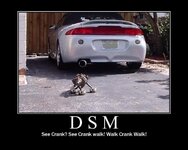Absit
20+ Year Contributor
- 2,390
- 40
- Dec 19, 2002
-
Davenport,
Iowa
I know crank walk has been discussed ad infinitum, and I'm not trying to convince anyone of anything, I just heard something from a local tuner today and wanted to get some more opinions on it.
The theory was that if you're not going to crankwalk anyway (block naturally inclined to it) you can still induce crankwalk by using a heavy clutch and running some decent power. He said to avoid this, before building decent power and upgrading to a heavier clutch, upgrade your rods to handle the stress of the extra pressure from the clutch (we were talking about 2gs, by the way).
Now it's been a long time since I read about crankwalk so if this is common now cool, if it's new to you guys, what do you think?
The theory was that if you're not going to crankwalk anyway (block naturally inclined to it) you can still induce crankwalk by using a heavy clutch and running some decent power. He said to avoid this, before building decent power and upgrading to a heavier clutch, upgrade your rods to handle the stress of the extra pressure from the clutch (we were talking about 2gs, by the way).
Now it's been a long time since I read about crankwalk so if this is common now cool, if it's new to you guys, what do you think?






















